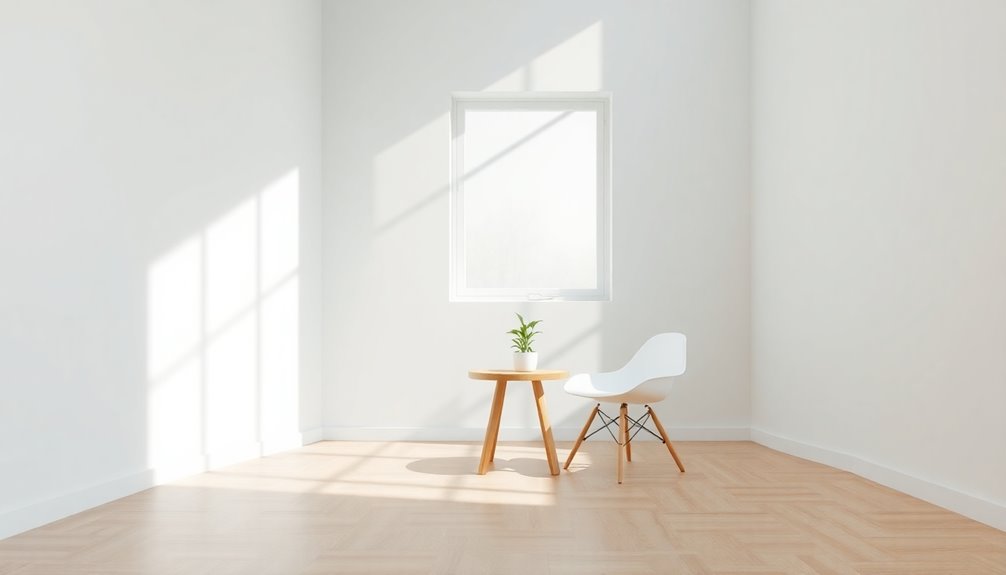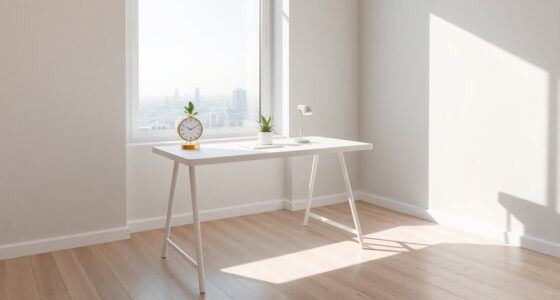In 2025, minimalism is all about intentional living, where you streamline technology use and embrace sustainable practices. You'll focus on personalized spaces that reflect your individuality while prioritizing wellness through natural materials and serene environments. Choosing high-quality, handcrafted items over unnecessary decorative pieces enhances authenticity. Decluttering your surroundings not only clears your mind but also promotes emotional health. If you're curious about how these trends will shape daily life, there's much more to explore.
Key Takeaways
- Digital minimalism will gain traction as individuals seek to reduce screen time and streamline their online presence for improved well-being.
- Sustainable and handcrafted items will become increasingly popular, promoting eco-friendly practices and supporting local artisans.
- Personalization of living spaces will trend, with a focus on keeping meaningful items and customizing environments to reflect individual goals.
- Wellness-centered design incorporating natural materials and biophilic elements will enhance emotional health and create serene living environments.
- Effective decluttering strategies will emphasize functional elegance, encouraging minimalistic spaces that foster mental clarity and reduce stress.
Intentional Technology Use
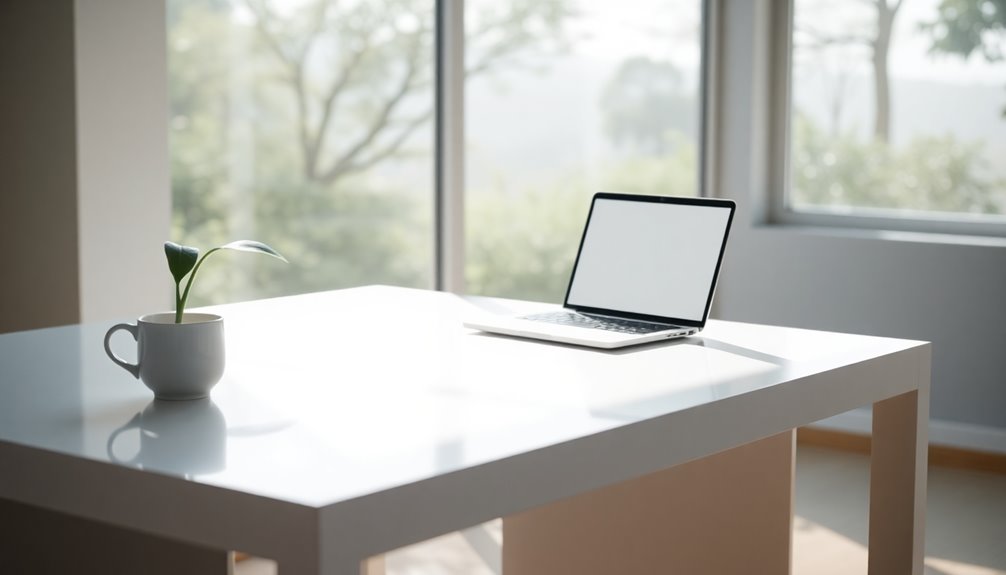
In today's fast-paced digital world, many people are discovering the benefits of intentional technology use. This trend emphasizes digital minimalism by encouraging you to declutter your virtual life.
You might find yourself reducing screen time and simplifying app usage, ultimately creating a more focused environment. Streamlining your email inbox and organizing cloud storage has become essential; you can adopt specific tools that meet your needs while cutting out distractions. Additionally, implementing structured data can enhance your online presence and improve search engine understanding as you curate your digital footprint.
Sustainable Minimalism
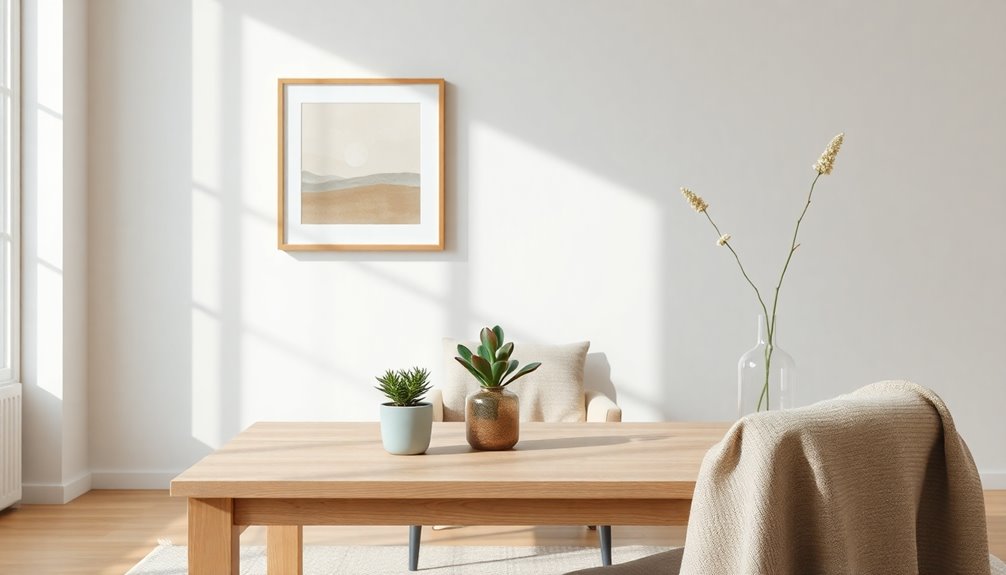
As awareness of environmental issues grows, sustainable minimalism is becoming a guiding principle for many. You're likely prioritizing secondhand shopping and choosing durable, long-lasting items to cut down on waste. This shift not only supports eco-friendly practices but also aligns your purchases with brands that practice ethical production.
| Sustainable Choices | Impact |
|---|---|
| Secondhand Shopping | Reduces waste |
| Timeless Quality Goods | Lasts longer |
| Donating Unwanted Items | Promotes circular economy |
Personalization in Minimalism
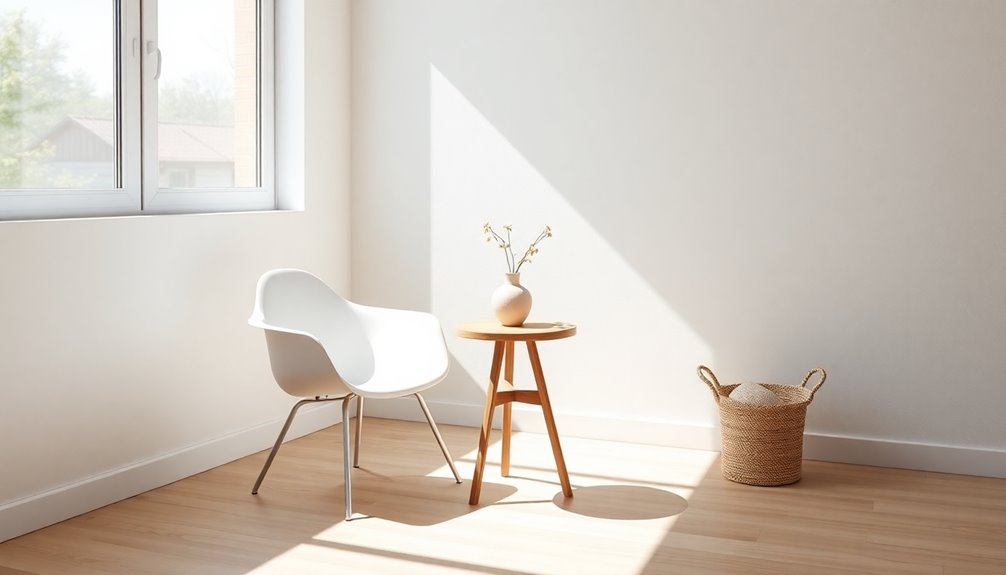
While minimalism traditionally focuses on reducing clutter, personalization is reshaping this philosophy by allowing you to keep items that truly matter.
This trend encourages you to customize your space and decluttering strategies, reflecting your unique lifestyle. Personalization in minimalism fosters a deeper connection with your environment, making your home a true reflection of you.
- Maintain sentimental items that bring joy
- Use visual decluttering workbooks to identify significance
- Opt for unique, handcrafted decor over mass-produced items
- Design your space to express individuality
As minimalism evolves, it's clear that the integration of personalization is essential for creating meaningful, tailored living spaces that resonate with who you are. Incorporating natural materials like wood and stone can enhance this personalized approach, making your space not only minimal but also warm and inviting.
Wellness-Centered Spaces
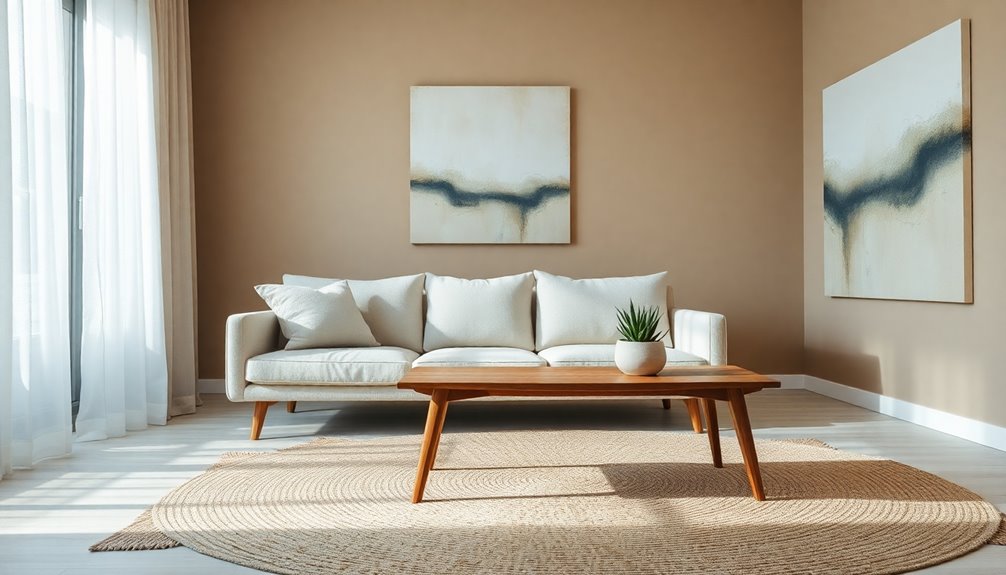
In 2025, your home will reflect wellness through the use of natural materials like wood and stone, creating a serene atmosphere. Incorporating biophilic design elements, such as indoor gardens and large windows, will strengthen your connection to nature. You'll also appreciate functional layouts that enhance comfort and ease, making your space a true sanctuary for relaxation and mindfulness. Additionally, embracing holistic living will foster a deeper sense of well-being and connection to your home and heritage.
Natural Material Integration
A shift toward wellness-centered spaces in 2025 highlights the integration of natural materials like wood and stone, creating environments that soothe and invite.
You'll find that these materials not only enhance aesthetics but also promote a sense of calm and connection to nature.
- Warm neutral color palettes set a cozy tone.
- Functional layouts reduce stress and enhance comfort.
- Eco-friendly and ethically sourced materials align with your values.
- Subtle layering adds depth without overwhelming the senses.
- Incorporating best woods for farmhouse tables can elevate both style and sustainability in your space.
Biophilic Design Elements
As you embrace natural materials in your space, consider how biophilic design elements can further enhance your wellness-centered environment.
By integrating features like expansive windows, you'll invite abundant natural light that connects you with the outdoors, boosting your mood and productivity.
Adding indoor gardens filled with lush plants not only beautifies your area but also creates a calming atmosphere essential for relaxation.
Using organic materials such as wood and stone complements the minimalist aesthetic while promoting tranquility.
Designating wellness-focused rooms, like home spas or meditation corners, allows you to escape daily stresses and cultivate mindfulness.
This growing trend towards biophilic design reflects a commitment to mental and physical health, making your home a true sanctuary. Furthermore, incorporating indoor water parks can provide a unique way to bring water elements into your home, enhancing the sense of serenity and relaxation.
Functional Layouts Emphasis
While prioritizing your well-being, you'll find that functional layouts in 2025 homes are designed to create spaces that support relaxation and mindfulness.
These layouts focus on promoting ease and comfort, ensuring your home is a sanctuary for mental and physical health.
- Natural materials like wood and stone enhance a calming atmosphere.
- Biophilic design elements, such as indoor gardens, strengthen your connection to nature.
- Ample natural light is incorporated to uplift your mood.
- Dedicated areas for mindfulness activities, like meditation and yoga, encourage daily practice.
As you embrace these wellness-centered spaces, you'll notice a significant reduction in stress, making your home more conducive to a healthy lifestyle. Additionally, incorporating moisture-resistant materials can further enhance the longevity and functionality of these serene environments.
Functional layouts are the key to nurturing your well-being.
Minimalism as Self-Care
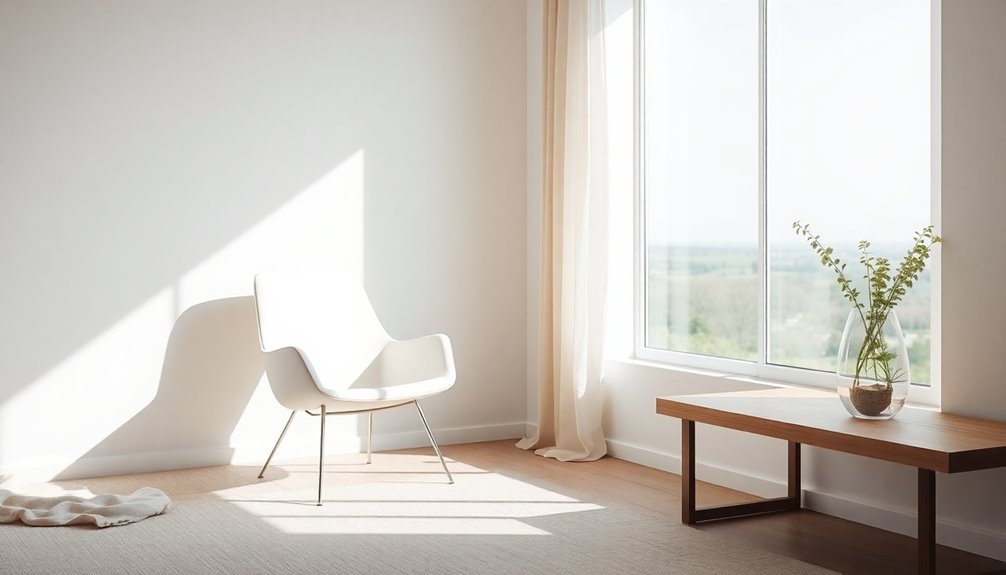
Minimalism isn't just about physical space; it's a powerful tool for your mental well-being.
By decluttering your environment, you create mental clarity that fosters mindfulness and intentional living.
Embracing this approach helps you focus on what truly matters, enhancing your overall sense of peace and purpose. Additionally, establishing routines can further aid in maintaining mental clarity and balance in your life.
Decluttering for Mental Clarity
When you take a moment to declutter your space, you're not just tidying up; you're actively creating a sanctuary for your mind.
Studies show that physical clutter can increase stress and anxiety, making decluttering essential for mental clarity. Dedicating just 15 minutes a day to small areas can foster immediate calm and a sense of accomplishment.
This practice enhances your emotional wellness, allowing you to focus on what truly matters.
- Reduces cognitive overload
- Promotes mindfulness
- Encourages meaningful relationships
- Aligns daily habits with personal goals
Additionally, maintaining a support network can further alleviate stress and enhance your overall well-being.
Embracing minimalism through decluttering helps you prioritize your well-being, ultimately leading to a more fulfilling life.
Mindfulness Through Simplification
Creating a serene environment extends beyond decluttering; it intertwines with mindfulness practices that nourish your soul.
Embracing minimalism as a form of self-care allows you to simplify your surroundings, reducing stress and enhancing mental clarity. Setting aside just 15 minutes daily to declutter small areas can bring immediate feelings of calm and improve your well-being.
By minimizing distractions, you can focus on what truly matters—meaningful relationships and long-term goals. Keep only the sentimental items that spark joy, fostering a deeper connection with your belongings and boosting your emotional health.
As you customize your decluttering strategies, you'll create a living space that reflects your personal goals, leading to a more intentional and fulfilling life. Routine health checks for your well-being can also enhance your mindfulness journey.
Mindfulness through simplification is a transformative journey.
Intentional Living Practices
By embracing intentional living practices, you can transform your home into a sanctuary that nurtures your well-being. Minimalist design plays an essential role in this process, promoting clarity and mindfulness.
Decluttering your space not only reduces stress but also allows you to focus on what truly matters. Incorporating sustainable materials into your decor can further enhance the tranquility of your environment while being kind to the planet.
Here are some tips to get started:
- Dedicate 15 minutes daily to declutter specific areas.
- Prioritize quality over quantity when choosing belongings.
- Foster emotional connections with fewer, meaningful items.
- Align daily habits with long-term goals for a fulfilling lifestyle.
Warmth and Texture
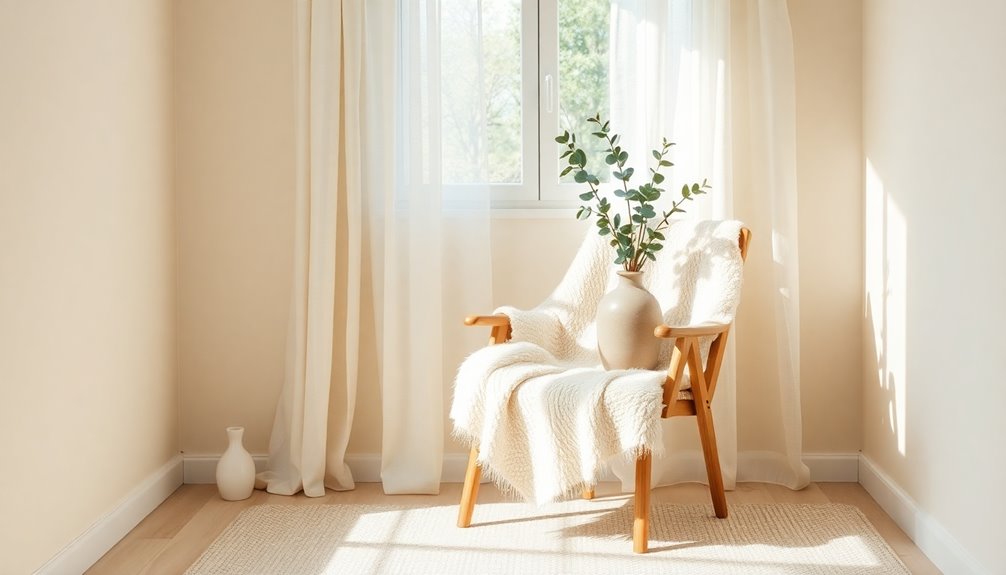
Warmth and texture are redefining minimalist spaces, making them feel more inviting and personal.
You'll notice a shift from stark whites to softer neutrals and natural materials like wood and stone. This change fosters an atmosphere of comfort and tranquility.
Cozy colors such as Benjamin Moore's Cinnamon Slate and Bewitched create soothing backdrops that enhance your emotional connection to your home.
Subtle layering techniques add depth and warmth, inviting you to relax.
Consider limewashing your walls with tan and clay tones to incorporate texture that enriches your space.
These choices reflect a growing desire for minimalist designs that prioritize comfort, ensuring your home feels both stylish and welcoming.
Embrace these elements to create an environment that truly resonates with you.
Items With Character
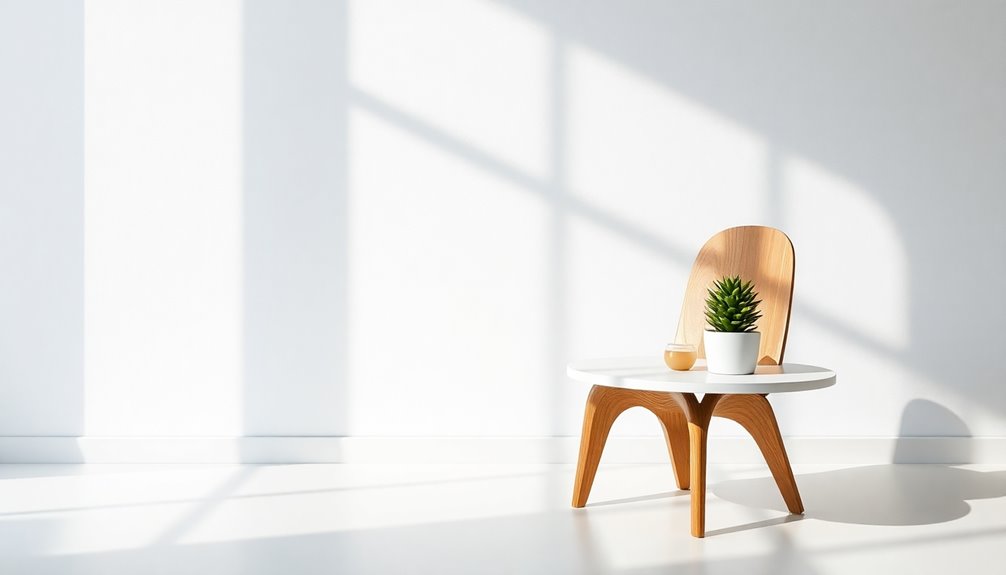
In 2025, you're likely drawn to handcrafted home decor that adds a unique touch to your space.
These artisan creations not only showcase exceptional craftsmanship but also tell a story that mass-produced items simply can't match.
Handcrafted Home Decor
As you explore the world of home decor, you'll find that handcrafted items are emerging as essential pieces that add character and depth to your living space.
The demand for unique handcrafted home decor reflects a shift away from generic store products. Inspired by the Italian coast and Tuscan hills, these items emphasize authenticity and the artistry of local artisans.
Consider incorporating these handcrafted pieces into your home:
- Unique vases that tell a story
- Custom furniture crafted with care
- Handwoven textiles that add warmth
- Artisan pottery with distinctive designs
Unique Artisan Creations
While many decor items lack personality, unique artisan creations stand out by infusing your home with character and story. The rising demand for handcrafted pieces showcases a shift toward items that reflect craftsmanship and provenance.
Imagine a stunning vase made by local artisans in Tuscany, capturing the essence of the picturesque region. These unique artisan creations offer more than mere aesthetics; they tell a story and connect you to the artist's vision.
With consumers increasingly seeking distinctive decor that aligns with their values, supporting local artisans and sustainable practices has never been more important. As generic decor loses its appeal, embrace unique artisan creations that truly resonate with your personal style and elevate your living space.
Decluttering
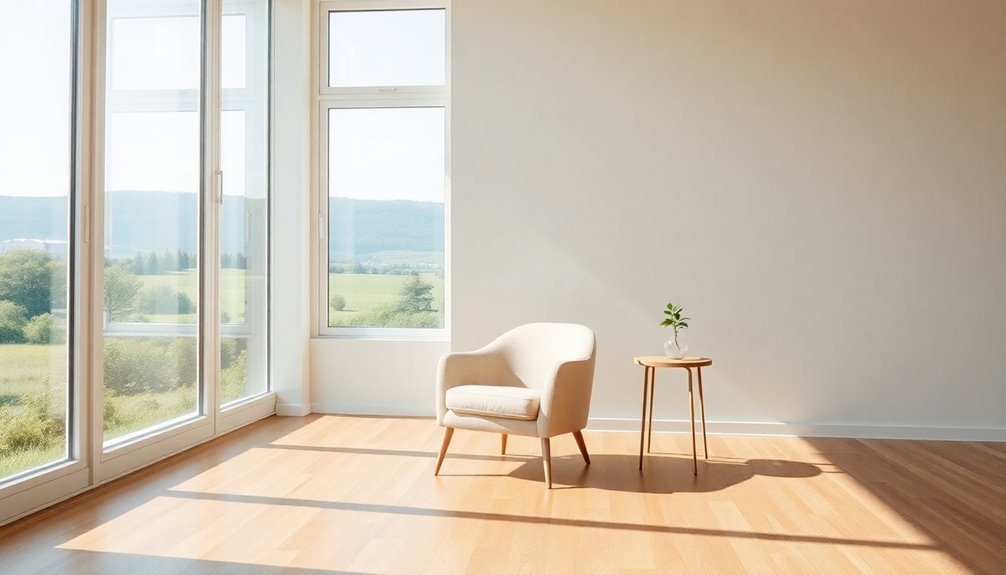
Decluttering transforms your space into a serene sanctuary, making it easier to focus on what truly matters.
Transform your environment into a peaceful retreat, allowing clarity and focus on what truly matters.
Embracing a minimalist lifestyle means creating a clean, less-is-more environment that highlights beauty in simplicity. Whole house decluttering not only improves organization but also aligns with the minimalist ethos.
Consider these tips for effective decluttering:
- Identify items that no longer serve a purpose.
- Invest in stylish storage solutions to maintain order.
- Choose beautiful furniture and art that reflect your style.
- Minimize decorative pieces to emphasize functional elegance.
Higher Quality Materials
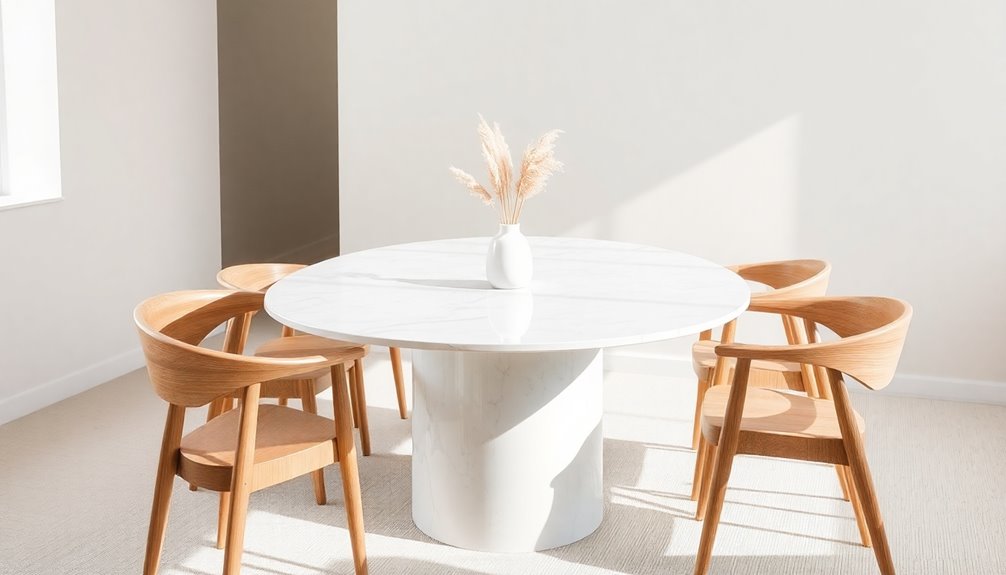
Embracing higher quality materials in your minimalist journey enhances both aesthetic appeal and functionality.
In 2025, you'll likely prioritize durable fabrics and finishes that embody the minimalist philosophy of longevity and sustainability. By investing in higher quality materials, like premium upholstery and solid wood furnishings, you'll reduce the need for additional decorative accessories.
This focus on quality over quantity encourages you to seek out timeless, well-crafted items that stand the test of time, contributing to a more sustainable lifestyle.
You'll find yourself drawn to aesthetic simplicity combined with functional durability, favoring fewer lasting items over disposable products.
This shift will also promote artisanal craftsmanship, allowing you to appreciate unique handmade goods that showcase exceptional quality materials.
Unnecessary Decorative Pieces

In 2025, you'll find that unnecessary decorative pieces have no place in a truly minimalist home. Embracing minimalist designs means prioritizing functionality and simplicity over excess.
This shift encourages you to focus on meaningful decor that serves a purpose, blending comfort with a clean aesthetic.
To achieve this streamlined look, consider these strategies:
- Use personal items as decor, showcasing individuality without clutter.
- Color block books or flip them for a neutral appearance.
- Limit decorative accessories to a few essential pieces.
- Choose furniture that doubles as storage to maintain a tidy space.
Frequently Asked Questions
What Is the Minimalist Trend in 2025?
In 2025, the minimalist trend focuses on sustainability and personalization.
You'll prioritize secondhand shopping and durable items to minimize waste while supporting ethical practices. Embracing sentimental pieces, you'll create spaces that reflect your unique style.
Higher quality materials become essential, promoting longevity over cheap alternatives.
Wellness-centered designs will enhance your environment, featuring natural elements that foster relaxation.
Finally, expect a blend of simplicity and luxury, with high-end finishes that add a touch of elegance.
What Is the Trend in Decor in 2025?
You might think minimalism means dull spaces, but it's evolving into something warm and inviting.
In 2025, decor trends focus on soft neutrals and natural materials like wood and stone, creating a cozy atmosphere. Unique, handcrafted decor pieces inspired by the Italian coast are gaining popularity, while high-quality furnishings take precedence over cheap alternatives.
The emphasis is on decluttering and styling personal items, allowing your space to reflect your personality beautifully.
Why Is Minimalism Becoming More Popular?
Minimalism's gaining popularity because you crave simplicity in a chaotic world.
You're likely looking to declutter both your physical and digital spaces, seeking clarity amidst the clutter. This trend also ties into sustainability, as you prioritize eco-friendly choices and durable items.
Plus, minimalism serves as a form of self-care, reducing your mental load and promoting mindfulness.
What Is the Design Forecast for 2025?
The design forecast for 2025 highlights a shift toward sustainable minimalism.
You'll see a rise in secondhand shopping and durable items, aiming to reduce waste.
Personalization will become essential, allowing you to express your unique style through decor.
Wellness-centered spaces will focus on natural materials that promote relaxation.
Multifunctional areas will gain popularity, blending living and working spaces, while higher quality materials will be prioritized, ensuring longevity and timeless appeal in your home.
Conclusion
As you embrace minimalism in 2025, picture a serene room with only a few carefully chosen pieces—a sleek gadget for intentional tech use, a handcrafted bowl that tells a story, and a plant that breathes life into the space. Each item reflects your values, promoting wellness and self-care. By decluttering and opting for higher quality materials, you create a sanctuary that resonates with who you are. In this simplicity, you find clarity and joy, proving less truly is more.
